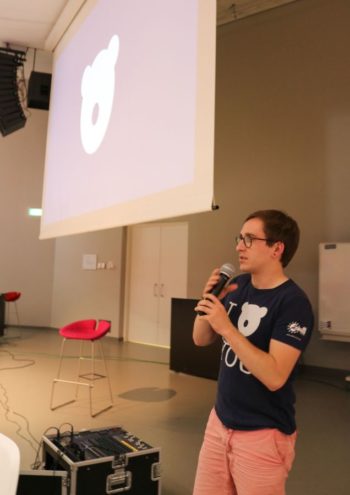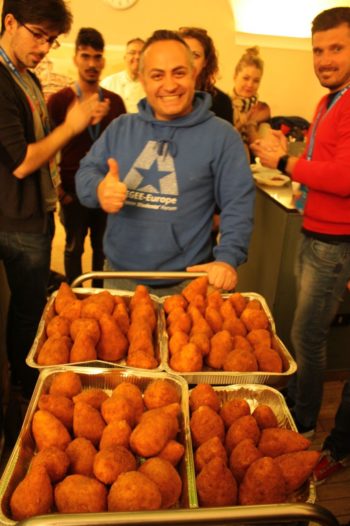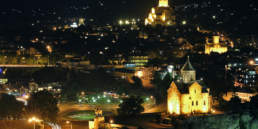Which headline would you like to see about Agora Catania? Probably nothing about fights on the stage or bureaucracy fatigue. What about a motivating Agora, an event that shows the participants why AEGEE was founded in first place: to work together with people from all over Europe in order to foster European integration. This little summary of Agora Catania is still completely fiction – but in four months it could be reality. It is up to you. Join us to the trip to the future.

AEGEE’s first general assembly in Sicily, which took place in the last week of September, will be remembered for two things: the great hospitality and perfect organization by AEGEE-Catania – and for its optimistic spirit. “It was an Agora that showed us how AEGEE can contribute to a better Europe” was a sentence that many delegates used. Especially the multitude of daring European projects, the creative thinking and the return of the Fields of Actions made many participants enthusiastic.
The great spirit was in parts due to a very successful pre-event that inspired many people. In AEGEE’s first “Project Lab” altogether 25 participants developed many amazing local and European project ideas that will be put into practice in 2018. In this three-day long event the participants also acquired knowledge and skills how to make a fantastic project. “It was very important to show that people don’t have to afraid to make a project. It’s not difficult at all”, said Philipp Blum, co-manager of the event. In two Agora workshops the Project Lab graduates inspired 100 other participants, who are already putting the new ideas to practice.
More action, less talking

Workshops were a key factor for the success of Agora Catania in general. The Chair and the CD decided to give a lot of space to the creative thinkers and visionary planners in the network. This was however only possible due to the fact that there were only very few proposals. “Somehow everyone realized that every single prytanium less means one amazing project more for AEGEE – and isn’t that why we joined AEGEE?”, said a satisfied workshop leader. “We really had the feeling that we could shape the future of Europe here at this Agora.” Instead of 20 there were only five proposals – just like it was common around 10-15 years ago when everyone was so busy with organizing things that proposals on deadlines or other technical issues did not matter so much.
There were so many things on the drawing board. For example the Migration Project, which was started by a few Italian locals right after the spring Agora in Enschede and has now already 15 confirmed conferences, debates and study trips in its calendar all over Europe. By the way, the project team is still looking for a host of the Final Conference, which shall have 300 participants from all over Europe in September 2018.
Focus on the future of the EU
 Also the multitude of EU-related anniversaries in 2017 inspired many people. AEGEE nearly missed the chance to give its own vision to the question where the EU stands right now and which road it shall take. Just a small recap of the anniversaries:
Also the multitude of EU-related anniversaries in 2017 inspired many people. AEGEE nearly missed the chance to give its own vision to the question where the EU stands right now and which road it shall take. Just a small recap of the anniversaries:
- 60th anniversary of Treaty of Rome (25 March 1957)
- 30 years of Erasmus (June 1987)
- 30th anniversary of the European Single Act (1 July 1987)
- 25 years of the Single Market (31 Dec 1992)
- 25 years since the signing of the Maastricht Treaty (7 February 1992)
- 15 years of Euro currency (January 2002)
- 10 years of EU membership of Romania and Bulgaria
“We nearly missed the chance to get inspired by these anniversaries”, said a delegate. “It is something different whether AEGEE joins in an activity of another association like with the Treaty of Rome anniversary in spring – or whether we make our own projects!”
Many people heard for the first time that AEGEE received more than 200,000 Euro funding for the “Europe & Euro” project in 1997. That milestone projects consisted out of 16 international and 10 local conferences, seminars and an essay competition. All these activities circled around many economical aspects of the EU and its currency. “Right now with the economic discrepancies in the Eurozone and populist tendencies this is the project we need. The new Europe & Euro project is perfect for our reputation”, said a former President of AEGEE-Europe. “If we do it right, there are many funding possibilities.”
Balkan, populism and more

Several of the other anniversaries were bundled in the “Quo Vadis Europe” project, which aims at addressing the EU fatigue in Europe and tries to suggest reforms for the union of states. Also the “Beautiful Balkan” project received a lot of attention. It analysed the political, economic and society-related perspectives of Romania and Bulgaria, but also of other countries, such as conflict-ridden Macedonia. And of course the project “Populism in Europe’s Heart” with conferences, seminars, a case study trip and other activities in the Visegrad countries Hungary, Poland, Slovakia and Czech Republic made many locals join.
Several of these projects were integrated spontaneously in the Action Agenda, since they fit very well in the new Focus Areas Equal Rights, Civic Education, Youth Development and European Citizenship. Of course there also other amazing projects related to equality, civic education and more – there were simply too many ideas to mention all of them here.
Demand for more trainings

“With all these events there will be a big demand in project mangement skills, which will create opportunities to kickstart the European Schools again”, said an Academy member. Also the idea of an AEGEE-Zagreb member to create an Intranet database of all international AEGEE events that dealt with these topics, including the programmes, was enthusiastically welcomed at the Agora.
Some concerns were raised whether AEGEE would find enough participants for all these projects. However, the majority of people argued that these great projects will attract many participants from outside of AEGEE – who then hopefully might then join AEGEE and help to create even more thematic events in the future. “This is our chance to stop the brain drain of AEGEE, to stop the loss of members that turn away and join other, more thematic associations. After years of gloom we don’t want to hear the words Shrinking Network anymore”, said a delegate.
Peace and stability

As you can see, the majority of the project discussed in Catania circled around the topic of “peace and stability”. This was not really a big surprise, since the EPM conference topics in the past years were about Refugees in Europe (2016), the relation between EU, Russia, and Ukraine (2015), nationalism (2014) and the future of Europe in general (2013). “These are the topics that people really care about, otherwise they would not have been selected by majority vote in the Agora”, said a delegate. “It is quite curious though that the Agora cares mostly about political topics when it comes to the EPM conference, but did not choose them for the Strategic Plan.”
 Many people in Catania still remembered what had happened at EPM Zagreb in February and the previous EPMs: As soon as the curtain fell over the conferences and the drafting of the Action Agenda started, the participants, who had queued for questions about populism or other conference topics, suddenly seemed to have rebooted their minds and completely focused on the four Focus Areas. In Zagreb, it would have been possible also to include many aspects of populism in a few Focus Areas, but this did not happen.
Many people in Catania still remembered what had happened at EPM Zagreb in February and the previous EPMs: As soon as the curtain fell over the conferences and the drafting of the Action Agenda started, the participants, who had queued for questions about populism or other conference topics, suddenly seemed to have rebooted their minds and completely focused on the four Focus Areas. In Zagreb, it would have been possible also to include many aspects of populism in a few Focus Areas, but this did not happen.
It was striking, painfully striking: among the Action Agenda draft ideas the word populism was never mentioned once. It was the same for example two years ago at EPM Burgos. The participants were very much into the discussions about Russia and Ukraine, but when the planning started, it was all gone and wiped out. Some people had wondered whether AEGEE had actually lost the ability to think out of the box.
Fortunately, Agora Catania proved that the opposite is true!
The return of the Fields of Action

“Peace and Stability” was one of the four “Main Fields of Action” until 2013, when the basic pillars of AEGEE were erased in order to give higher significance to the Strategic Plan and the Action Agenda. Agora Catania saw the reform of the reform – it brought back the Fields of Action “Higher Education”, “Peace & Stability”, “Cultural exchange” and “Active Citizenship” after a proposal successfully passed.
How did that happen?
It started at Agora Enschede when during the last day a team of four people – Marina Klanjcic, Pablo Palazon, Viola Bianchetti and Alvaro Gonzalez Perez – made many delegates familiar with the Fields of Action, which served AEGEE for around 15 years. “It was always so easy to explain potential members at info desks what AEGEE is about”, said an AEGEE oldie in Enschede. “You just showed the sheet with the pillars of the Fields of Action that held the roof of AEGEE – and they understood.”
The four presenters in Enschede used a different argument that convinced many people: “A strategy that changes every year is not a strategy. The Fields of Action represent better what we permanently stand for.” Over the following four months they explained the members what would improve if the Fields of Action were back – and succeeded.
Also the Yearplan Projects are back

The Agora in Catania decided also to bring back the Yearplan and Flagship Projects and to make them the core of the Action Agenda. Many people might still not be familiar with those terms, so here is the recap.
Starting with 1994, AEGEE created the ancient predecessor to the Strategic Plan and the Action Agenda: the Long Term Programme (LTP) and the Yearplan. Even Focus Areas existed, they were called “Baskets” of the Long Term Programme, which lasted three years. However, while the current Agenda Agenda sometimes loses itself in managing small separate objectives, the Yearplan was aiming at outlining up to three big parallel European projects, involving usually many antennae.
The Long Term Programme was just seen as a guideline, the Agora preserved itself the flexibility to change the thematic baskets, when they saw a big topic on the horizon or when locals with a great idea stepped up and presented a Yearplan concept. Since the LTP was in practice not followed, it was replaced at Agora Udine in November 2000 by the four Main Fields of Action as constant reference, a Strategy Plan for the next three years and the Yearplan.
Only much later the clear-cut Yearplan with a few big projects was replaced by the Action Agenda. So why did Agora Catania regarded the Yearplan as better than the more diverse Action Agenda? The issue that objectives should be measurable was as important back then as it has been in recent years. But there is a difference: AEGEE looked at the aspect “measurable” first and foremost in regard to the reached target group. The Yearplan on the other hand had a double perspective: the Yearplan projects did not only specify the number of events and participants; since the events were usually thematic conferences carried out by antennae, much more people were involved as organisers. And this was good for the network: the antennae made great events, strengthened the skills of the organisers and helpers and got potentially new members in the process since the target group of the events were students.
The structure is the key
Of course, there were also Yearplan projects similar to today’s objectives. An example: the project “Europe Needs You 2” in 2010 involved 10 people in 10 locals, which gave 21 workshops to high school kids (http://www.projects.aegee.org/youropeneedsyou/). A few 100 pupils took part, but only very few members benefitted from the acquired skills. Their locals did not benefit very much, since they were not involved as such.
In comparison, the aforementioned project “Euro & Euro” had these dimensions: five large conferences plus five small seminars, ten local events, one final international conference, one essay competition, 2000 participants, 150 speakers in 11 countries, wide media coverage and a great result book. The measurable impact was much bigger. To use the words of “Europe & Euro” project manager Bart Neerscholten: “We distributed more than 20.000 posters across 2500 European universities and colleges, created an informative website, and received nearly 250 essays and over 1000 completed questionnaires on the European Monetary Union.”
Between 2001 and 2005 AEGEE conducted breathtaking 30 international European-wide projects, each consisting of several activities – that’s six new projects per year. When you look at the AEGEE AddressBook of 2002, it listed 19 projects which had just started, were in full swing or just finished.
The hope that AEGEE can reach these numbers again one day convinced the delegates in Catania to vote for the proposed reform.
So what is next?
2018 will still be a bumpy road, as always after big reforms. Nevertheless, the enthusiasm in the network after Agora Catania is stronger than in many years before. The delegates are optimistic to meet the challenges: the antennae need skills and knowledge. If it works, then AEGEE will be stronger than now – and have a big impact on Europe. And that’s worth fighting for!


